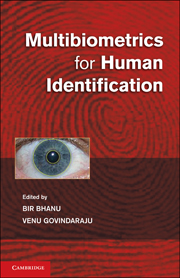Book contents
- Frontmatter
- Contents
- List of Contributors
- Preface
- Introduction
- PART I MULTIMODAL AND MULTISENSOR BIOMETRIC SYSTEMS
- PART II FUSION METHODS IN MULTIBIOMETRIC SYSTEMS
- PART III HYBRID BIOMETRIC SYSTEMS
- PART IV DATABASES AND SECURITY
- 12 Acquisition and Analysis of a Dataset Comprising Gait, Ear, and Semantic Data
- 13 Dynamic Security Management in Multibiometrics
- PART V PERFORMANCE OF MULTIBIOMETRIC SYSTEMS
- Plate section
12 - Acquisition and Analysis of a Dataset Comprising Gait, Ear, and Semantic Data
from PART IV - DATABASES AND SECURITY
Published online by Cambridge University Press: 25 October 2011
- Frontmatter
- Contents
- List of Contributors
- Preface
- Introduction
- PART I MULTIMODAL AND MULTISENSOR BIOMETRIC SYSTEMS
- PART II FUSION METHODS IN MULTIBIOMETRIC SYSTEMS
- PART III HYBRID BIOMETRIC SYSTEMS
- PART IV DATABASES AND SECURITY
- 12 Acquisition and Analysis of a Dataset Comprising Gait, Ear, and Semantic Data
- 13 Dynamic Security Management in Multibiometrics
- PART V PERFORMANCE OF MULTIBIOMETRIC SYSTEMS
- Plate section
Summary
Introduction
Multibiometrics
With the ever increasing demand for security and identification systems, the adoption of biometric systems is becoming widespread. There are many reasons for developing multibiometric systems; for example, a subject may conceal or lack the biometric a system is based on. This can be a significant problem with noncontact biometrics in some applications (e.g., surveillance). Many noncontact biometric modalities exist. Of these face recognition has been the most widely studied, resulting in both its benefits and drawbacks being well understood. Others include gait, ear, and soft biometrics. Automatic gait recognition is attractive because it enables the identification of a subject from a distance, meaning that it will find applications in a variety of different environments (Nixon et al. 2005). The advantage of the ear biometric is that the problems associated with age appear to be slight, though enrolment can be impeded by hair (Hurley et al. 2008). There are also new approaches to using semantic descriptions to enhance biometric capability, sometimes known as soft biometrics (Samangooei et al. 2008). The semantic data can be used alone, or in tandem with other biometrics, and are suited particularly to analysis of surveillance data.
The deployment of mutilbiometric systems is largely still at a research phase (Ross et al. 2006). Of the biometrics discussed here, some approaches fuse face with gait (Shakhnarovich and Darrell 2002; Liu and Sarkar 2007; Zhou and Bhanu 2007; Yamauchi et al. 2009) and some that fuse ear with face (Chang et al. 2003). No approach has fused gait and ear data.
- Type
- Chapter
- Information
- Multibiometrics for Human Identification , pp. 277 - 301Publisher: Cambridge University PressPrint publication year: 2011
- 16
- Cited by

